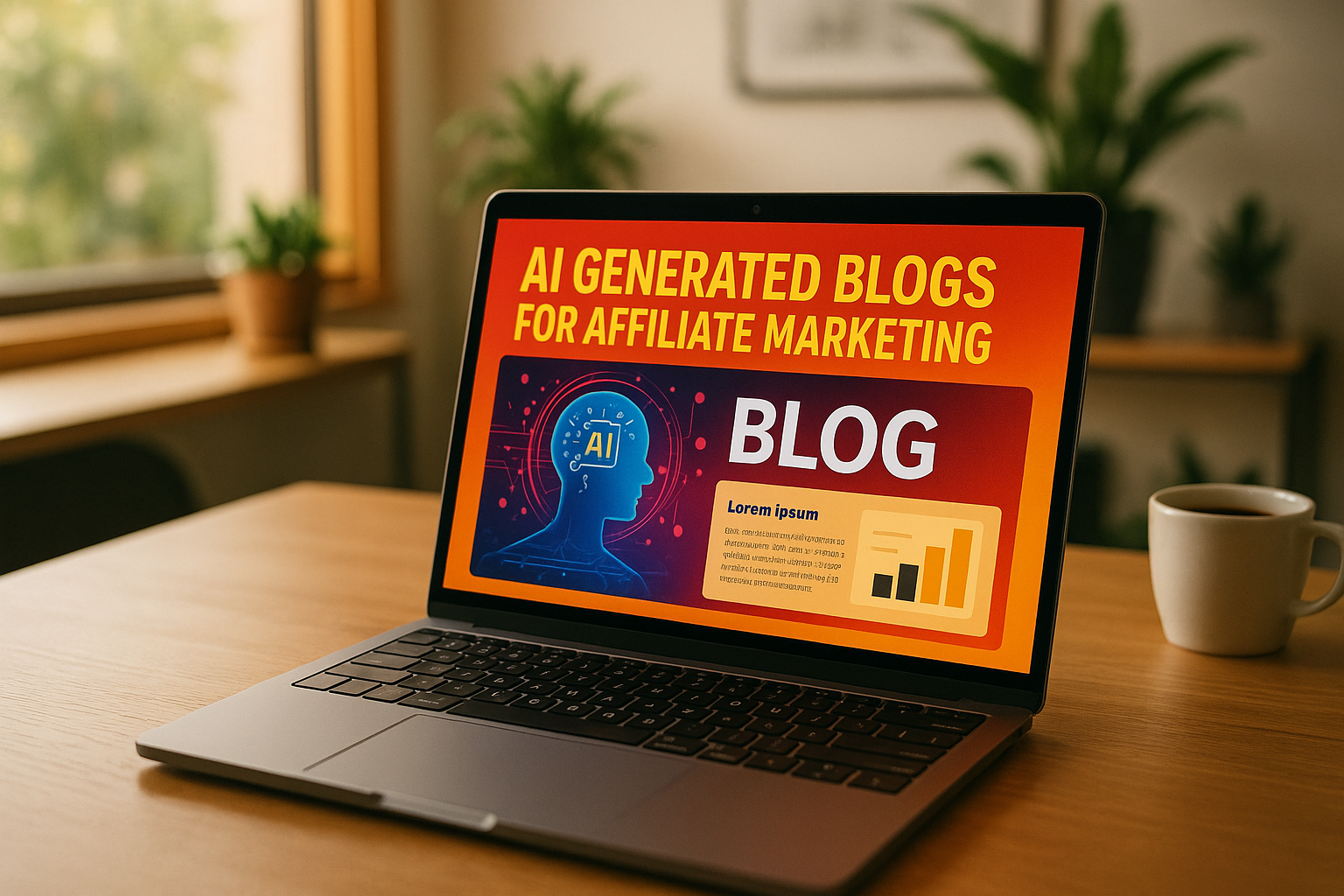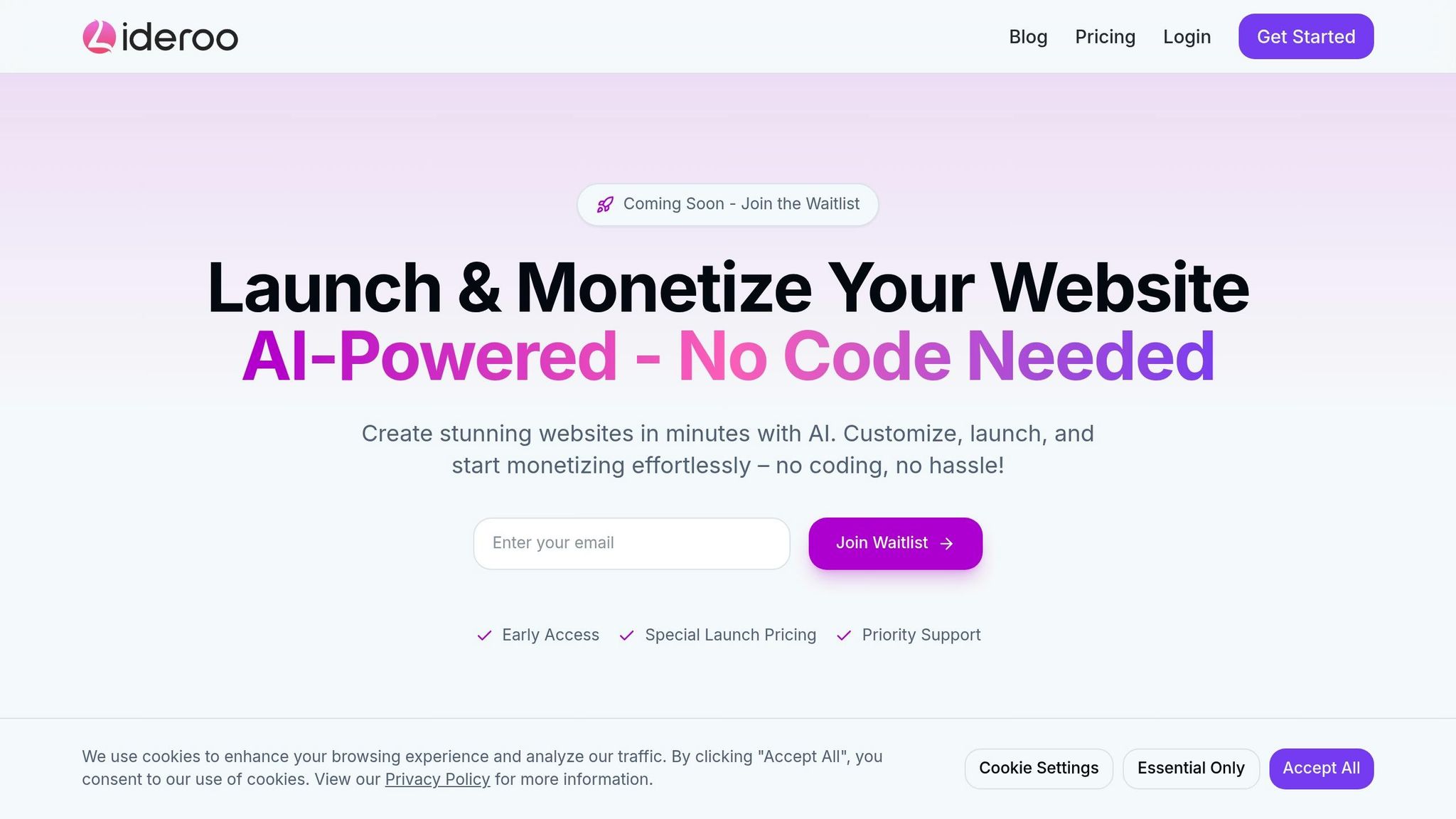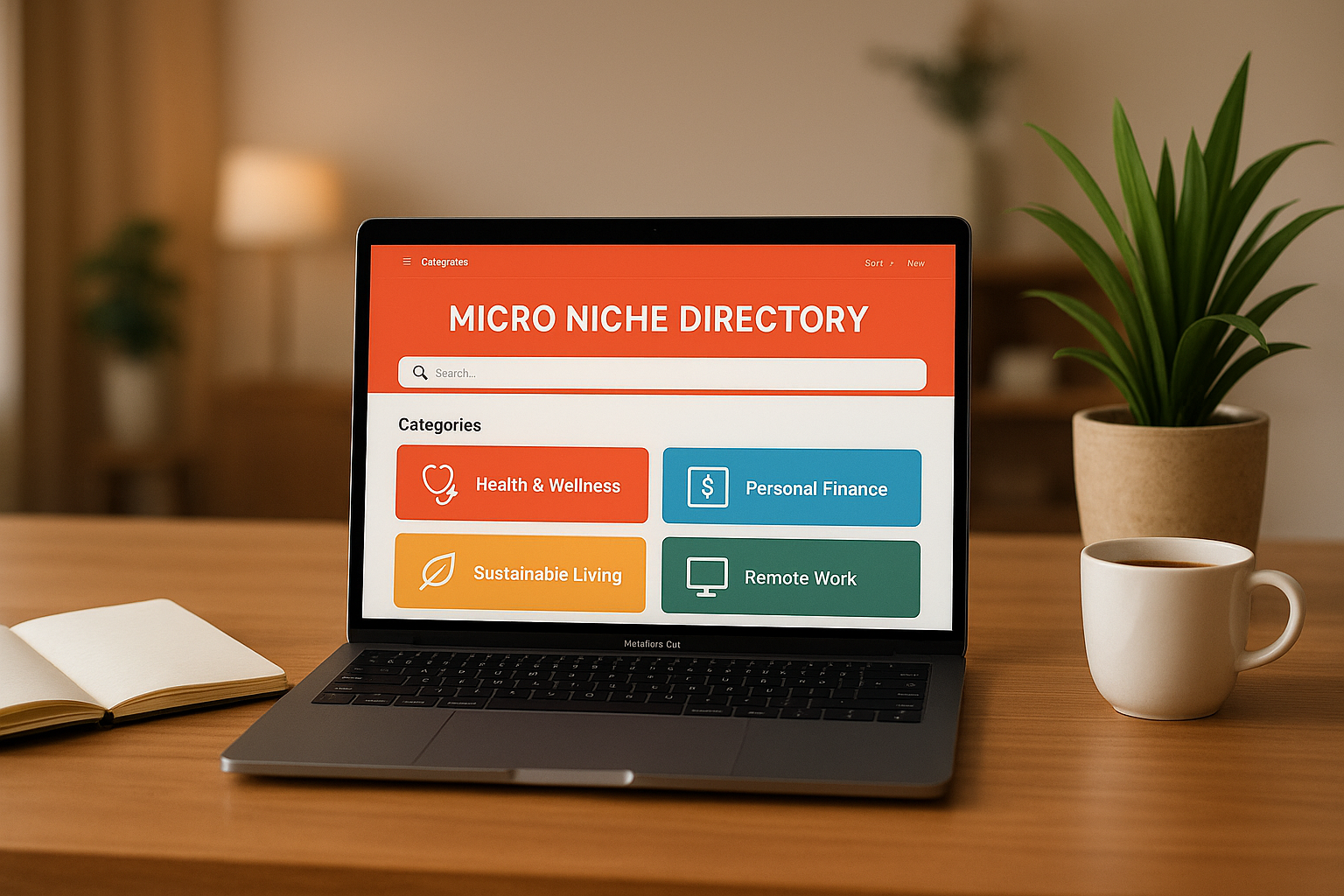AI Generated Blogs for Affiliate Marketing

AI is transforming affiliate marketing by automating blog creation, saving time, and boosting revenue. Here’s what you need to know:
- Why It Matters: AI can increase affiliate revenue by up to 30% by automating time-consuming tasks like writing, SEO optimization, and audience targeting.
- Key Benefits:
- Creates content in minutes, not hours.
- Finds low-competition keywords for better SEO.
- Personalizes content for specific audiences based on data.
- Offers tools for tracking performance and improving strategies.
- Challenges Solved: Manual blog creation is slow, inconsistent, and hard to scale. AI tools streamline these processes, making them faster and more efficient.
Quick Overview
| Feature | Manual Blogs | AI-Generated Blogs |
|---|---|---|
| Time to Create Content | Hours to days | Minutes |
| SEO Optimization | Requires expertise | Automated |
| Personalization | Limited | Data-driven |
| Scalability | Difficult | Easy |
| Performance Tracking | Manual | Built-in analytics |
AI tools like Lideroo simplify blog creation with drag-and-drop editors, automatic SEO, and built-in monetization options. By blending AI’s speed with human oversight, you can create better content, faster.
Takeaway: Use AI to save time, boost traffic, and increase conversions in your affiliate marketing strategy.
Affiliate Marketing with AI in 2024 (FULL Beginner’s Guide)
Using AI Tools for Affiliate Content Creation
Creating affiliate content manually can be a slow and frustrating process. AI tools, however, offer a way to streamline and scale your efforts, turning what used to be a grind into an efficient operation. But here’s the catch - not all AI tools are built the same. Knowing which features matter most can make all the difference in boosting your affiliate revenue. Let’s explore the must-have features and see how Lideroo brings them all together.
Key Features to Look for in AI Writing Tools
When picking an AI tool for affiliate content, natural language processing (NLP) should be a priority. Advanced NLP capabilities allow the tool to handle complex tasks while producing content that feels natural and connects with real readers.
Another must-have is SEO integration. The right tool will take care of keyword research, optimize your content, and even manage internal linking strategies. This ensures your content ranks well while staying relevant to your audience.
Versatility is also critical. Look for a platform that can create more than just blog posts. Whether it’s social media updates, video scripts, email campaigns, or product descriptions, having one tool that handles it all keeps your messaging consistent across channels.
A plagiarism checker is non-negotiable. Since AI tools can sometimes produce overlapping content, this feature ensures your work remains original and valuable to both readers and search engines.
For content that converts, audience analysis capabilities are essential. By analyzing data like user preferences and behaviors, these tools help you craft targeted content that speaks directly to your audience’s needs and interests.
Lastly, consider tools offering referral tracking, ad optimization, and landing page design. These features can simplify your entire affiliate marketing funnel.
How Lideroo Simplifies AI-Powered Blog Creation

Finding a tool with all these features can give you a real edge, and Lideroo is a great example of how it’s done. This platform takes the hassle out of affiliate blog creation with its AI-powered, no-code website builder designed for content creators and marketers alike. Here’s how it works:
- Drag-and-Drop Editor: Lideroo’s user-friendly editor lets you customize templates without touching a single line of code. From product recommendations to comparison tables and call-to-action buttons, everything is easy to set up. You can go from concept to a fully functional affiliate blog in just hours.
- AI-Driven Content Generation: Lideroo’s AI creates blog posts tailored to your niche, keywords, and audience preferences. It even adapts the tone to match your brand voice, ensuring your content is both engaging and on-target. Plus, it keeps your messaging consistent across all platforms.
- Automatic SEO Optimization: Forget wrestling with technical SEO tasks. Lideroo handles meta tags, sitemaps, and provides optimization tips based on trends and competitor data.
- Built-In Monetization Tools: This feature is a game-changer. From premium content sections to subscription plans and payment processing, Lideroo eliminates the need for third-party integrations. You can focus on content while the platform takes care of the backend.
- Advanced Analytics: With detailed insights into user behavior, content performance, and revenue attribution, Lideroo helps you make smarter, data-driven decisions to refine your affiliate strategy.
Adopting AI tools like Lideroo isn’t just about saving time - it’s about results. Businesses using AI in their marketing have reported up to a 20% increase in revenue. With its all-in-one approach, Lideroo equips you to achieve better conversions and manage your content with ease, making it an invaluable tool for affiliate marketers.
Optimizing AI-Generated Blogs for SEO and Engagement
Once you’ve effortlessly created content using AI tools, the next step is refining it to maximize SEO performance and reader engagement. With 40% of search results now including AI Overviews as of April 2025, and 60% of Google searches in 2024 ending without users leaving the search results page, standing out has become more challenging. However, AI-generated content can perform well if optimized effectively.
SEO Best Practices for AI-Generated Content
SEO strategies have shifted to prioritize topics and user intent over traditional keyword-based methods. Steven van Vessum, VP of Organic Marketing at FamilyCare, highlights this shift:
“People need to think in terms of topics rather than keywords”.
To align with this approach, focus on the E-E-A-T principles: Experience, Expertise, Authoritativeness, and Trustworthiness. By integrating unique insights that showcase genuine expertise in your niche, you can elevate your content’s credibility. Patrick Reinhart from Conductor reinforces this idea:
“The best way to optimize is to be original”.
Incorporating structured data through Schema markup is another critical step. This helps AI-driven search engines better understand your content, improving its visibility. Additionally, optimizing for featured snippets can significantly boost click-through rates - by as much as 42%. To achieve this, structure your content to answer common questions clearly and concisely. Use short paragraphs, bullet points, and tables to make your content easier for AI crawlers to process. Including long-tail keywords in your text can further enhance your chances of appearing in snippets, potentially increasing visibility by up to 55.5%.
Establishing authority is equally important. Consistently publishing high-quality, expert-level content helps position your site as a reliable source, which AI search engines increasingly favor.
Don’t rely solely on Google for traffic. As generative AI search engine usage has grown 5.25x since January 2024, with 8% of users now turning to ChatGPT as their primary search engine, diversifying your optimization efforts is essential. Each platform has unique preferences - Google prioritizes structured data, ChatGPT values widely cited content, Perplexity favors research-backed pages, and Claude prefers clear, instructional material.
Improving Readability and Engagement
To keep readers engaged, aim for sentences around 17 words in length and organize content into clear sections with H2/H3 headers, short paragraphs, and bullet points. Research involving 410 newspapers found that 8-word sentences achieve 100% reader comprehension, while sentences over 29 words drop comprehension to just 4.5%.
Apply the CRAFT method - Cut words, Review accuracy, Add value, Fact-check, and Trust but verify - to ensure your content is clear and impactful. This method helps maintain the human touch that readers appreciate.
Go beyond generic information by adding meaningful value. For example, TV 2 Fyn, a Danish news outlet, used AI to generate alternative headlines and A/B tested them against human-written versions. The result? A 59% average increase in click-through rates. Editorial oversight remains essential for maintaining quality and relevance.
Make sure your content is mobile-friendly and loads quickly. These technical SEO factors are vital as mobile traffic continues to dominate online usage.
Finally, closely monitor performance metrics. Use AI tools to analyze click-through rates, bounce rates, and engagement trends to understand what resonates with your audience. In one case study, affiliates leveraging AI personalization tools saw a 35% increase in click-through rates over three months by creating hyper-personalized content.
The secret lies in blending AI’s efficiency with thoughtful human oversight. By following these optimization strategies, you can enhance visibility, boost engagement, and ultimately drive higher conversion rates.
sbb-itb-dfa823a
Best Practices for Adding Affiliate Links
When used thoughtfully, affiliate links can enhance your content and provide value to your readers without coming off as overly promotional. The trick lies in placing these links naturally and ensuring they’re easy to trust and track. Let’s break down how to do this effectively.
Natural Placement of Affiliate Links
Affiliate links work best when they feel like a natural part of your content. They should appear in places where readers are already looking for recommendations or solutions. As Syed Balkhi, Founder of WPBeginner, wisely notes:
“When it comes to adding affiliate links to your website, transparency is key. Being open about adding affiliate links to your website is crucial to build trust amongst your audience”.
Context is everything. For example, embedding links in product reviews, tutorials, or comparison guides ensures they’re relevant and helpful. Audrey Scott of Uncornered Market does this brilliantly in her blog post about the Camino de Santiago, where she shares packing tips and seamlessly includes affiliate links to recommended products. Similarly, Matthew Karsten from Expert Vagabond provides an in-depth guide on the best backpacks for travelers, weaving in affiliate links that serve his audience’s needs.
Another key tactic is to use descriptive anchor text. Instead of vague phrases like “click here”, opt for specific terms such as “lightweight camping stove” or “waterproof hiking boots.” This approach not only builds trust but also helps readers understand exactly what they’re clicking on.
Timing matters, too. Place affiliate links after you’ve delivered substantial value, such as detailed advice or in-depth comparisons. Kristin from Be My Muse Blog exemplifies this by first offering a comprehensive packing checklist and then naturally linking to her favorite gear.
Once your links are thoughtfully placed, you can enhance their effectiveness with cloaking and tracking.
Using Link Cloaking and Tracking
Link cloaking takes those long, messy affiliate URLs and turns them into clean, branded links that look professional and inspire confidence. This practice not only improves click-through rates but also protects your commissions and provides valuable tracking data.
For example, instead of displaying a confusing affiliate URL filled with tracking parameters, you could use a branded link like “yourdomain.com/tools/email-platform” or “yourblog.com/recommends/hiking-boots.” These descriptive URLs clearly indicate the destination, making them more transparent and user-friendly.
When setting up cloaked links, choose the right redirect type. A 307 redirect is ideal for most affiliate links because it maintains SEO compliance while ensuring you get credit for referrals. Proper redirects also help search engines understand your links without penalizing your site.
Tracking is another critical step. Use cloaking tools to monitor click data and identify which links or pieces of content drive the most conversions. This insight allows you to tweak underperforming links and maximize your revenue potential.
Before going live, test your redirect paths on both desktop and mobile devices. Ensure that affiliate parameters are passed correctly, page loading speeds remain unaffected, and analytics tools are accurately capturing clicks. These checks can prevent lost commissions and ensure your audience has a smooth browsing experience.
Lastly, stay compliant with search engine guidelines and legal requirements. Add attributes like rel="sponsored" or rel="nofollow" to your cloaked links to align with SEO best practices. Be transparent with your audience by including clear affiliate disclosures, such as “This post contains affiliate links”, to meet FTC requirements.
Regularly monitor your links to catch broken redirects or expired affiliate programs. This ensures your links remain functional and your tracking data stays accurate, protecting your revenue and maintaining a positive user experience.
Following Compliance and Ethical Guidelines
Creating affiliate content with AI adds layers of complexity, especially when it comes to meeting disclosure and ethical standards. Failing to comply can lead to hefty fines and damage your reputation.
FTC Disclosure Requirements
The Federal Trade Commission (FTC) mandates that content creators disclose any material connection with brands in a clear and visible way. This includes AI-generated and sponsored content, which requires explicit dual disclosures.
The consequences of non-compliance can be severe. For instance, Google and iHeartMedia were fined $9.4 million for airing nearly 29,000 deceptive endorsements for the Google Pixel 4 phone. Influencers promoted the device without ever using it. As Samuel Levine, Director of the Bureau of Consumer Protection, put it:
“Google and iHeartMedia paid influencers to promote products they never used, showing a blatant disrespect for truth-in-advertising rules.”
In August 2024, the FTC solidified its stance by banning AI-generated fake reviews, with penalties similar to those for other violations. Recent cases, like AccessiBe’s $1 million penalty and DoNotPay’s $193,000 fine, highlight the financial risks tied to non-compliance.
If you’re using AI to create affiliate content, your disclosures must stand out. Place them at the beginning of your content using simple language, such as: “This post contains affiliate links and was created with AI assistance.” Avoid hiding disclosures in hashtags or using vague terms like “collab” or “sp.” Make sure disclosures match the language of your content and appear on every platform where the content is shared. Relying solely on platform-specific disclosure tools isn’t enough - manual disclosures are still necessary. These steps are critical for maintaining transparency and trust.
Keeping Content Authentic
Ensuring authenticity goes hand in hand with compliance. While earlier sections covered technical strategies, this part focuses on keeping your content credible and legally sound.
Never publish AI-generated reviews without testing the product yourself. Making claims about products you haven’t used can lead to FTC violations. Maintain detailed records of AI-generated outputs and any edits you make. These logs can serve as proof of authenticity and protect you in case of compliance issues.
Transparency and authenticity are the cornerstones of successful affiliate marketing. Marketers like Pat Flynn from Smart Passive Income openly disclose their affiliate relationships, while Wirecutter provides detailed product reviews alongside upfront disclosures about their affiliate links.
A balanced approach works best. Use AI for initial drafts and research, but have humans handle final reviews, fact-checking, and verifying sensitive claims. Training your team on AI ethics and best practices ensures your content meets high standards across the board.
Conclusion: Getting the Most from AI-Generated Affiliate Blogs
AI is reshaping affiliate marketing, turning it into a more streamlined, data-driven approach. With the global affiliate marketing industry surpassing $17 billion in 2024, it’s clear that this space is ripe for innovation. Experts forecast that AI will influence over 50% of digital marketing strategies by 2025. By adopting AI tools, you can boost efficiency and unlock new opportunities for growth.
Key Takeaways
Research shows that AI-powered affiliate marketing can increase revenues by as much as 30%. This growth is fueled by AI’s ability to deliver personalized experiences and optimize campaigns in real time. Plus, automating repetitive tasks like keyword research and content creation allows you to focus on big-picture decisions and building relationships.
However, the key to success lies in blending AI’s capabilities with human authenticity. For instance, in 2024, ContentLab found that articles created using AI-generated outlines but enriched with human storytelling saw 28% higher engagement rates compared to content created solely by AI. This aligns with digital marketing expert Neil Patel’s wisdom:
“Authenticity isn’t a nice-to-have - it’s the foundation for building meaningful connections online.”
Being transparent about AI’s role in your content can also enhance trust. Studies show that clear communication about AI usage can increase returning visitors by up to 15%. While compliance is necessary, it can also be a competitive advantage when handled thoughtfully.
Currently, over 58% of marketers use AI tools for content creation, and 86% of consumers say authenticity is a deciding factor when choosing brands to support. The winning formula combines AI’s efficiency with genuine human insights and experiences.
Next Steps for Getting Started
To make the most of AI in affiliate marketing, start with a strong foundation. Define your niche and audience - this will shape everything from the products you promote to your content strategy. With 31% of U.S. publishers ranking affiliate marketing among their top three revenue sources, picking the right focus is essential for long-term success.
Choose affiliate programs that align with your values and interests. This not only makes your content feel more genuine but also helps you avoid compliance issues by promoting products you truly understand and believe in.
Platforms like Lideroo can simplify the technical side of things, allowing you to focus on strategy and audience engagement. While the platform handles content generation, you maintain editorial control, ensuring your unique voice and expertise shine through.
From day one, track key metrics like organic traffic, engagement rates, and conversions. Use these insights to fine-tune your approach and scale what works. As affiliate marketer Pharoah puts it:
“AI is like having an entire marketing team working for you 24/7 - except you don’t have to pay salaries, and it never takes breaks. They analyze, optimize, and execute without hesitation.”
Start small by testing different strategies, then scale the ones that deliver results. By combining AI’s efficiency with your authentic voice, you can build a solid foundation for sustained growth in affiliate marketing.
FAQs
How can AI-generated content boost SEO for affiliate marketing blogs?
AI tools can play a crucial role in boosting SEO for affiliate marketing blogs by seamlessly weaving in targeted keywords, addressing relevant topics, and ensuring a steady flow of well-written content. This combination not only helps improve search engine rankings but also draws in more organic traffic.
On top of that, AI simplifies the content creation process. It enables you to publish blogs more often without compromising on quality. These tools also offer data-driven insights to refine your content strategy, enhance user engagement, and drive conversions. By incorporating AI into your workflow, you can save valuable time while unlocking your blog’s potential to generate more affiliate income.
What ethical guidelines and compliance rules should I follow when using AI to create affiliate marketing content?
When leveraging AI to create affiliate marketing content, keeping transparency and accuracy front and center is crucial. Be upfront about affiliate relationships by clearly disclosing them - this not only aligns with FTC guidelines but also builds trust with your readers. Additionally, make sure the AI-generated content is truthful, avoids any misleading statements, and respects the privacy of your audience.
On the compliance side, stick to regulations like FTC rules in the U.S. and GDPR if you’re reaching international audiences. Steer clear of making claims you can’t verify, and handle personal data responsibly. Regularly review your affiliate content to ensure it stays within legal and ethical boundaries. Taking these steps helps safeguard your brand while maintaining your audience’s confidence.
How does Lideroo use AI to create personalized content for different audience segments in affiliate marketing?
Lideroo uses AI to dive deep into user behavior, preferences, and demographics, allowing for the creation of highly tailored content that connects with specific audience groups. By adjusting blog content and affiliate links to match individual user needs, it delivers a more engaging and relevant experience.
This level of personalization not only increases engagement but also helps drive higher conversion rates by focusing on what truly matters to your audience. With AI-powered insights, you can fine-tune your affiliate marketing strategy with ease, cutting down on the time spent making manual tweaks.


